How Was the Late Neogene Red Clay Formed in the Ordos Plateau (Northwest China)?
Abstract
1. Introduction
2. Research Background
2.1. Provenance of Detrital Zircon in Red Clay
2.2. Tectonic and Climatic Setting
2.3. Rivers and Deserts
2.4. Late Miocene–Pliocene Red Clay Profile
3. Research Methods
3.1. Data Sources
3.2. Data Processing
4. Results
5. Discussion
5.1. Provenance of Potential Source Area of Red Clay
5.2. Provenance of Red Clay
5.3. Formation Mechanism of Red Clay
6. Conclusions
- (1)
- The Late Miocene and Pliocene red clay in the Ordos Plateau primarily originates from the upper and middle Yellow River and the Wei River. The weathering of bedrock in the western part of the North China Craton plays a secondary role in the development of the red clay. The deposition of red clay in the late Miocene and Pliocene of the Ordos Plateau follows a proximal accumulation pattern.
- (2)
- The extensive deposition of Late Miocene and Pliocene red clay in the Ordos Plateau is attributed to the abundant fluvial clastic material, intensified East Asian winter monsoon, flat topography of the Ordos Plateau, and the presence of the Qinling and Taihang Shan as geomorphic barriers. The Tarim Basin, Mongolian Gobi, and Qaidam Basin were not the primary sources of red clay deposits in the Ordos Plateau.
Author Contributions
Funding
Acknowledgments
Conflicts of Interest
References
- Tang, Z.H.; Ding, Z.L. A palynological insight into the Miocene aridification in the Eurasian interior. Palaeoworld 2013, 22, 77–85. [Google Scholar] [CrossRef]
- Rodríguez-López, J.P.; Clemmensen, L.B.; Lancaster, N.; Mountney, N.P.; Veiga, G.D. Archean to Recent aeolian sand systems and their sedimentary record: Current understanding and future prospects. Sedimentology 2014, 61, 1487–1534. [Google Scholar] [CrossRef]
- Rea, D.K. The paleoclimatic record provided by eolian deposition in the deep sea: The geologic history of wind. Rev. Geophys. 1994, 32, 159–195. [Google Scholar] [CrossRef]
- Garzanti, E.; Vermeesch, P.; Andò, S.; Vezzoli, G.; Valagussa, M.; Allen, K.; Kadi, K.A.; Al-Juboury, A.I. Provenance and recycling of Arabian desert sand. Earth-Sci. Rev. 2013, 120, 1–19. [Google Scholar] [CrossRef]
- Rittner, M.; Vermeesch, P.; Carter, A.; Bird, A.; Stevens, T.; Garzanti, E.; Andò, S.; Vezzoli, G.; Dutt, R.; Xu, Z.; et al. The provenance of Taklamakan desert sand. Earth Planet. Sci. Lett. 2016, 437, 127–137. [Google Scholar] [CrossRef]
- Licht, A.; Folch, A.; Sylvestre, F.; Yacoub, A.N.; Cogné, N.; Abderamane, M.; Deschamps, P. Provenance of aeolian sands from the southeastern Sahara from a detrital zircon perspective. Quat. Sci. Rev. 2024, 328, 108539. [Google Scholar] [CrossRef]
- von Eynatten, H.; Dunkl, I. Assessing the sediment factory: The role of single grain analysis. Earth-Sci. Rev. 2012, 115, 97–120. [Google Scholar] [CrossRef]
- Bird, A.; Stevens, T.; Rittner, M.; Vermeesch, P.; Carter, A.; Andò, S.; Garzanti, E.; Lu, H.; Nie, J.; Zeng, L.; et al. Quaternary dust source variation across the Chinese Loess Plateau. Palaeogeogr. Palaeoclimatol. Palaeoecol. 2015, 435, 254–264. [Google Scholar] [CrossRef]
- Ding, Z.L.; Xiong, S.F.; Sun, J.M.; Yang, S.L.; Gu, Z.Y.; Liu, T.S. Pedostratigraphy and paleomagnetism of a ~7.0 Ma eolian loess–red clay sequence at Lingtai, Loess Plateau, north-central China and the implications for paleomonsoon evolution. Palaeogeogr. Palaeoclimatol. Palaeoecol. 1999, 152, 49–66. [Google Scholar] [CrossRef]
- Shang, Y.; Beets, C.J.; Tang, H.; Prins, M.A.; Lahaye, Y.; van Elsas, R.; Kaakinen, A. Variations in the provenance of the late Neogene Red Clay deposits in northern China. Earth Planet. Sci. Lett. 2016, 439, 88–100. [Google Scholar] [CrossRef]
- Sun, Y.; Yan, Y.; Nie, J.; Li, G.; Shi, Z.; Qiang, X.; An, Z. Source-to-sink fluctuations of Asian aeolian deposits since the late Oligocene. Earth-Sci. Rev. 2020, 200, 102963. [Google Scholar] [CrossRef]
- Bohm, K.; Stevens, T.; Kaakinen, A.; Lahaye, Y.; O‘Brien, H.; Zhang, Z. The provenance of late Cenozoic East Asian Red Clay: Tectonic-metamorphic history of potential source regions and a novel combined zircon-rutile approach. Earth-Sci. Rev. 2022, 225, 103909. [Google Scholar] [CrossRef]
- Sun, J.; Ding, Z.; Xiao, W.; Windley, B.F. Coupling between uplift of the Central Asian Orogenic Belt-NE Tibetan Plateau and accumulation of aeolian Red Clay in the inner Asia began at ~7 Ma. Earth-Sci. Rev. 2022, 226, 103919. [Google Scholar] [CrossRef]
- Guo, Z.T.; Ruddiman, W.F.; Hao, Q.Z.; Wu, H.B.; Qiao, Y.S.; Zhu, R.X.; Liu, T.S. Onset of Asian desertification by 22 Myr ago inferred from loess deposits in China. Nature 2002, 416, 159–163. [Google Scholar] [CrossRef] [PubMed]
- Fang, X.; Garzione, C.; Van der Voo, R.; Li, J.; Fan, M. Flexural subsidence by 29 Ma on the NE edge of Tibet from the magnetostratigraphy of Linxia Basin, China. Earth Planet. Sci. Lett. 2003, 210, 545–560. [Google Scholar] [CrossRef]
- Lu, H.; Wang, X.; An, Z.; Miao, X.; Zhu, R.; Ma, H.; Li, Z.; Tan, H.; Wang, X. Geomorphologic evidence of phased uplift of the northeastern Qinghai-Tibet Plateau since 14 million years ago. Sci. China Earth Sci. 2004, 47, 822–833. [Google Scholar] [CrossRef]
- Qiang, X.; An, Z.; Song, Y.; Chang, H.; Sun, Y.; Liu, W.; Ai, L. New eolian red clay sequence on the western Chinese Loess Plateau linked to onset of Asian desertification about 25 Ma ago. Sci. China Earth Sci. 2011, 54, 136–144. [Google Scholar] [CrossRef]
- Zhang, Y.; Sun, D.; Li, Z.; Wang, F.; Wang, X.; Li, B.; Wu, S. Cenozoic record of aeolian sediment accumulation and aridification from Lanzhou, China, driven by Tibetan Plateau uplift and global climate. Glob. Planet. Change 2014, 120, 1–15. [Google Scholar] [CrossRef]
- Lin, X.; Wyrwoll, K.H.; Chen, H.; Zhang, X.; Fu, K.; Sun, M.; Shen, Z. An active east Asian monsoon at the Oligocene-Miocene boundary: Evidence from the Sikouzi Section, Northern China. J. Geol. 2015, 123, 355–367. [Google Scholar] [CrossRef]
- Ruan, X.; Yang, Y.; Galy, A.; Fang, X.; Jin, Z.; Zhang, F.; Yang, R.; Deng, L.; Meng, Q.; Ye, C.; et al. Evidence for early (≥12.7 Ma) eolian dust impact on river chemistry in the northeastern Tibetan Plateau. Earth Planet. Sci. Lett. 2019, 515, 79–89. [Google Scholar] [CrossRef]
- Wasiljeff, J.; Salminen, J.M.; Stenman, J.; Zhang, Z.; Kaakinen, A. Oligocene moisture variations as evidenced by an aeolian dust sequence in Inner Mongolia, China. Sci. Rep. 2022, 12, 5597. [Google Scholar] [CrossRef]
- Bohm, K.; Wasiljeff, J.; Stevens, T.; Salminen, J.; Tang, H.; Lahaye, Y.; Kurhila, M.; Zhang, Z.; Haugvaldstad, O.; Kaakinen, A. Modern-type eolian regime and global cooling-modulated dust provenance in the late Paleogene of Central-East Asia. Geochem. Geophys. Geosystems 2024, 25, e2023GC011167. [Google Scholar] [CrossRef]
- Sun, D.H.; An, Z.S.; Shaw, J.; Bloemendal, J.; Youbin, S. Magnetostratigraphy and palaeoclimatic significance of Late Tertiary aeolian sequences in the Chinese Loess Plateau. Geophys. J. Int. 1998, 134, 207–212. [Google Scholar]
- Qiang, X.K.; Li, Z.X.; Powell, C.M.; Zheng, H.B. Magnetostratigraphic record of the Late Miocene onset of the East Asian monsoon, and Pliocene uplift of northern Tibet. Earth Planet. Sci. Lett. 2001, 187, 83–93. [Google Scholar] [CrossRef]
- Hao, Q.; Guo, Z. Magnetostratigraphy of a late Miocene-Pliocene loess-soil sequence in the western Loess Plateau in China. Geophys. Res. Lett. 2004, 31, 1–4. [Google Scholar] [CrossRef]
- Zhu, Y.; Zhou, L.; Mo, D.; Kaakinen, A.; Zhang, Z.; Fortelius, M. A new magnetostratigraphic framework for late Neogene Hipparion Red Clay in the eastern Loess Plateau of China. Palaeogeogr. Palaeoclimatol. Palaeoecol. 2008, 268, 47–57. [Google Scholar] [CrossRef]
- Xu, Y.; Yue, L.; Li, J.; Sun, L.; Sun, B.; Zhang, J.; Ma, J.; Wang, J. An 11-Ma-old red clay sequence on the Eastern Chinese Loess Plateau. Palaeogeogr. Palaeoclimatol. Palaeoecol. 2009, 284, 383–391. [Google Scholar] [CrossRef]
- Nie, J.; Peng, W.; Möller, A.; Song, Y.; Stockli, D.F.; Stevens, T.; Horton, B.K.; Liu, S.; Bird, A.; Oalmann, J.; et al. Provenance of the upper Miocene–Pliocene Red Clay deposits of the Chinese loess plateau. Earth Planet. Sci. Lett. 2014, 407, 35–47. [Google Scholar] [CrossRef]
- Alonso-Zarza, A.M.; Zhao, Z.; Song, C.H.; Li, J.J.; Zhang, J.; Martín-Pérez, A.; Zhang, M.H. Mudflat/distal fan and shallow lake sedimentation (upper Vallesian–Turolian) in the Tianshui Basin, Central China: Evidence against the late Miocene eolian loess. Sediment. Geol. 2009, 222, 42–51. [Google Scholar] [CrossRef]
- Vandenberghe, J.; Sun, Y.; Wang, X.; Abels, H.A.; Liu, X. Grain-size characterization of reworked fine-grained aeolian deposits. Earth-Sci. Rev. 2018, 177, 43–52. [Google Scholar] [CrossRef]
- Liu, S.; Li, J.; Stockli, D.F.; Song, C.; Guo, B.; Stockli, L.D.; Ma, Z.; Li, X.; Peng, T. Reappraisal of Miocene eolian deposition in Tianshui Basin, China, based on an investigation of stratigraphy and provenance. Geol. Soc. Am. Bull. 2019, 131, 1312–1332. [Google Scholar] [CrossRef]
- Lu, H.; Vandenberghe, J.; An, Z. Aeolian origin and palaeoclimatic implications of the ‘red clay’(north China) as evidenced by grain-size distribution. J. Quat. Sci. Publ. Quat. Res. Assoc. 2001, 16, 89–97. [Google Scholar] [CrossRef]
- Yu, J.; Zheng, D.; Pang, J.; Li, C.; Wang, Y.; Wang, Y.; Hao, Y.; Zhang, P. Cenozoic mountain building in eastern China and its correlation with reorganization of the Asian climate regime. Geology 2022, 50, 859–863. [Google Scholar] [CrossRef]
- Lin, X.; Liu-Zeng, J.; Wu, L.; Cleber, S.J.; Liu, D.; Dai, J.; Hu, C.; Chen, X.; Li, L.; Zhang, L. Meso–Cenozoic exhumation in the South Qinling Shan (Central China) Recorded by detrital apatite fission-track dating of modern river sediments. Minerals 2023, 13, 1314. [Google Scholar] [CrossRef]
- Wang, B.; Zheng, H.; He, Z.; Wang, P.; Kaakinen, A.; Zhou, X. Middle Miocene eolian sediments on the southern Chinese Loess Plateau dated by magnetostratigraphy. Palaeogeogr. Palaeoclimatol. Palaeoecol. 2014, 411, 257–266. [Google Scholar] [CrossRef]
- Shang, Y. Provenance and Sedimentology of Red Clay and Loess in Northern China. Ph.D. Thesis, University of Helsinki, Helsinki, Finland, 2018; pp. 1–45. [Google Scholar]
- Jiang, H.; Ding, Z. Eolian grain-size signature of the Sikouzi lacustrine sediments (Chinese Loess Plateau): Implications for Neogene evolution of the East Asian winter monsoon. Sci. Bull. 2010, 122, 843–854. [Google Scholar] [CrossRef]
- Zhang, H.; Lu, H.; He, J.; Xie, W.; Wang, H.; Zhang, H.; Breecker, D.; Bird, A.; Stevens, T.; Nie, J.; et al. Large-number detrital zircon U-Pb ages reveal global cooling caused the formation of the Chinese Loess Plateau during Late Miocene. Sci. Adv. 2022, 8, eabq2007. [Google Scholar] [CrossRef]
- Stevens, T.; Palk, C.; Carter, A.; Lu, H.; Clift, P.D. Assessing the provenance of loess and desert sediments in northern China using U-Pb dating and morphology of detrital zircons. Geol. Soc. Am. Bull. 2010, 122, 1331–1344. [Google Scholar] [CrossRef]
- Nie, J.; Pullen, A.; Garzione, C.N.; Peng, W.; Wang, Z. Pre-Quaternary decoupling between Asian aridification and high dust accumulation rates. Sci. Adv. 2018, 4, 1–8. [Google Scholar] [CrossRef]
- Peng, W.; Zhang, H.; Pullen, A.; Li, M.; Pan, B.; Xiao, W.; Nie, J. Stepwise increased spatial provenance contrast on the Chinese Loess Plateau over late Miocene-Pleistocene. Commun. Earth Environ. 2023, 4, 60. [Google Scholar] [CrossRef]
- Bohm, K.; Kaakinen, A.; Stevens, T.; Lahaye, Y.; O‘Brien, H.; Tang, H.; Shang, Y.; Zhang, H.; Lu, H. Neogene global climate change and East Asian dust sources: Combined rutile geochemistry and zircon U-Pb analysis from the northern Chinese Loess Plateau. Glob. Planet. Change 2023, 221, 104049. [Google Scholar] [CrossRef]
- Meijer, N.; Dupont-Nivet, G.; Licht, A.; Trabucho-Alexandre, J.; Bourquin, S.; Abels, H.A. Identifying eolian dust in the geological record. Earth-Sci. Rev. 2020, 211, 103410. [Google Scholar] [CrossRef]
- Collins, A.L.; Blackwell, M.; Boeckx, P.; Chivers, C.A.; Emelko, M.; Evrard, O.; Foster, I.; Gellis, A.; Gholami, H.; Granger, S.; et al. Sediment source fingerprinting: Benchmarking recent outputs, remaining challenges and emerging themes. J. Soils Sediments 2020, 20, 4160–4193. [Google Scholar] [CrossRef] [PubMed]
- Gong, H.; Nie, J.; Wang, Z.; Peng, W.; Zhang, R.; Zhang, Y. A comparison of zircon U-Pb age results of the Red Clay sequence on the central Chinese Loess Plateau. Sci. Rep. 2016, 6, 29642. [Google Scholar] [CrossRef] [PubMed]
- Wang, X.; Flynn, L.J.; Fortelius, M. Fossil Mammals of Asia: Neogene Biostratigraphy and Chronology; Columbia University Press: Columbia, UK, 2013; pp. 1–760. [Google Scholar]
- Pan, F.; Li, J.; Xu, Y.; Yue, L.; Wingate, M.T.; Li, Y.; Guo, L.; Xi, R.; Guo, L. Provenance of Neogene eolian red clay in the Altun region of western China—Insights from UPb detrital zircon age data. Palaeogeogr. Palaeoclimatol. Palaeoecol. 2016, 459, 488–494. [Google Scholar] [CrossRef]
- Gong, H.; Xie, W.; Zhang, R.; Zhang, Y. U-Pb ages of detrital zircon and provenances of Red Clay in the Chinese Loess Plateau. J. Asian Earth Sci. 2017, 138, 495–501. [Google Scholar] [CrossRef]
- Zhang, H.; Lu, H.; Stevens, T.; Feng, H.; Fu, Y.; Geng, J.; Wang, H. Expansion of dust provenance and aridification of Asia since ~7.2 Ma revealed by detrital zircon U-Pb dating. Geophys. Res. Lett. 2018, 45, 13–437. [Google Scholar] [CrossRef]
- Lease, R.O.; Burbank, D.W.; Hough, B.; Wang, Z.; Yuan, D. Pulsed Miocene range growth in northeastern Tibet: Insights from Xunhua Basin magnetostratigraphy and provenance. Geol. Soc. Am. Bull. 2012, 124, 657–677. [Google Scholar] [CrossRef]
- Saylor, J.E.; Jordan, J.C.; Sundell, K.E.; Wang, X.; Wang, S.; Deng, T. Topographic growth of the Jishi Shan and its impact on basin and hydrology evolution, NE Tibetan Plateau. Basin Res. 2018, 30, 544–563. [Google Scholar] [CrossRef]
- Bao, G.; Chen, H.; Zhao, X. Late Miocene Yellow River formation in Qingtongxia area, North China: Detrital zircon and heavy mineral analysis at Niushou Mountain, Ningxia. Geol. J. 2020, 55, 7304–7321. [Google Scholar] [CrossRef]
- Li, W.D.; Zhao, X.T.; Yang, Y.; Wu, Z.H. Formation age and provenance analysis of the gravel layer in the Yellow River terraces of the Hetao Basin. Acta Geol. Sin. 2020, 41, 515–524, (In Chinese with English abstract). [Google Scholar]
- Zhang, H.; Lu, H.; Zhou, Y.; Cui, Y.; He, J.; Lv, H.; Wang, K.; Wang, X. Heavy mineral assemblages and UPb detrital zircon geochronology of sediments from the Weihe and Sanmen Basins: New insights into the Pliocene-Pleistocene evolution of the Yellow River. Palaeogeogr. Palaeoclimatol. Palaeoecol. 2021, 562, 110072. [Google Scholar] [CrossRef]
- Wang, Z.; Nie, J.S.; Peng, W.B.; Zhang, H.; Li, M. Late Pliocene sedimentary provenance of the Yinchuan Basin and its constraints on the formation age of the upper Yellow River. Acta Sedimentol. Sin. 2022, 40, 924–930, (In Chinese with English abstract). [Google Scholar]
- Lin, X.; Li, L.; Liu, H.J.; Chen, J. The upper reaches of the Yellow River did not flow into the Jinshan Gorge during the Neogene. J. Palaeogeogr. 2022, 24, 568–582, (In Chinese with English abstract). [Google Scholar]
- Lu, H.; Zhang, H.; Feng, H.; Wang, Y.; Cai, D.; Li, G.; Wang, X. Landform evolution in Asia during the Cenozoic revealed by formation of drainages of Wei River and Indus River. Palaeogeogr. Palaeoclimatol. Palaeoecol. 2023, 619, 111516. [Google Scholar] [CrossRef]
- Li, M.; Hu, Z.; Wang, P.; Pan, B.; Bridgland, D.; Mo, Q.; Li, X.; Dong, Z.; Zhong, M.; Pan, R.; et al. Plio-Pleistocene drainage reorganization in the middle Yellow River of China, revealed by provenance and paleocurrent analysis of fluvial sediments. Geomorphology 2024, 454, 109177. [Google Scholar] [CrossRef]
- Xie, J.; Yang, S.; Ding, Z. Methods and application of using detrital zircons to trace the provenance of loess. Sci. China Earth Sci. 2012, 55, 1837–1846. [Google Scholar] [CrossRef]
- Che, X.; Li, G. Binary sources of loess on the Chinese Loess Plateau revealed by U-Pb ages of zircon. Quat. Res. 2013, 80, 545–551. [Google Scholar] [CrossRef]
- Licht, A.; Dupont-Nivet, G.; Pullen, A.; Kapp, P.; Abels, H.A.; Lai, Z.; Giesler, D. Resilience of the Asian atmospheric circulation shown by Paleogene dust provenance. Nat. Commun. 2016, 7, 12390. [Google Scholar] [CrossRef]
- Zhang, H.; Lu, H.; Xu, X.; Liu, X.; Yang, T.; Stevens, T.; Feng, H. Quantitative estimation of the contribution of dust sources to Chinese loess using detrital zircon U-Pb age patterns. J. Geophys. Res. Earth Surf. 2016, 121, 2085–2968. [Google Scholar] [CrossRef]
- Yang, L.R.; Zou, N.; Yue, L.P.; Guo, H.J. Distribution of U-Pb ages of detrital zircon from the Hobq Desert and its implications for provenance. Quat. Sci. 2017, 37, 560–569, (In Chinese with English abstract). [Google Scholar]
- Li, M.; Nie, J.; Li, Z.; Pullen, A.; Abell, J.T.; Zhang, H.; Pan, B. A middle Pleistocene to Holocene perspective on sediment sources for the Tengger Desert, China. Catena 2023, 228, 107119. [Google Scholar] [CrossRef]
- Stevens, T.; Carter, A.; Watson, T.P.; Vermeesch, P.; Andò, S.; Bird, A.F.; Sevastjanova, I. Genetic linkage between the Yellow River, the Mu Us desert and the Chinese loess plateau. Quat. Sci. Rev. 2013, 78, 355–368. [Google Scholar] [CrossRef]
- Anderson, R.S.; Hallet, B. Sediment transport by wind: Toward a general model. Geol. Soc. Am. Bull. 1986, 97, 523–535. [Google Scholar] [CrossRef]
- Arimoto, R. Eolian dust and climate: Relationships to sources, tropospheric chemistry, transport and deposition. Earth-Sci. Rev. 2001, 54, 29–42. [Google Scholar] [CrossRef]
- Liang, M.; Guo, Z.; Kahmann, A.J.; Oldfield, F. Geochemical characteristics of the Miocene eolian deposits in China: Their provenance and climate implications. Geochem. Geophys. Geosystems 2009, 10, 1–16. [Google Scholar] [CrossRef]
- Wang, W.; Zhang, P.; Yu, J.; Wang, Y.; Zheng, D.; Zheng, W.; Zhang, H.; Pang, J. Constraints on mountain building in the northeastern Tibet: Detrital zircon records from synorogenic deposits in the Yumen Basin. Sci. Rep. 2016, 6, 27604. [Google Scholar] [CrossRef] [PubMed]
- Cheng, F.; Garzione, C.; Jolivet, M.; Wang, W.; Dong, J.; Richter, F.; Guo, Z. Provenance analysis of the Yumen Basin and northern Qilian Shan: Implications for the pre-collisional paleogeography in the NE Tibetan plateau and eastern termination of Altyn Tagh fault. Gondwana Res. 2019, 65, 156–171. [Google Scholar] [CrossRef]
- Miao, Y.; Fang, X.; Sun, J.; Xiao, W.; Yang, Y.; Wang, X.; Farnsworth, A.; Huang, K.; Ren, Y.; Wu, F.; et al. A new biologic paleoaltimetry indicating Late Miocene rapid uplift of northern Tibet Plateau. Science 2022, 378, 1074–1079. [Google Scholar] [CrossRef]
- Jolivet, M.; Brunel, M.; Seward, D.; Xu, Z.; Yang, J.; Roger, F.; Wu, C. Mesozoic and Cenozoic tectonics of the northern edge of the Tibetan plateau: Fission-track constraints. Tectonophysics 2001, 343, 111–134. [Google Scholar] [CrossRef]
- Lin, X.; Chen, H.; Wyrwoll, K.H.; Batt, G.E.; Liao, L.; Xiao, J. The uplift history of the Haiyuan-Liupan Shan region northeast of the present Tibetan Plateau: Integrated constraint from stratigraphy and thermochronology. J. Geol. 2011, 119, 372–393. [Google Scholar] [CrossRef]
- Zheng, D.; Wang, W.; Wan, J.; Yuan, D.; Liu, C.; Zheng, W.; Zhang, H.; Pang, J.; Zhang, P. Progressive northward growth of the northern Qilian Shan–Hexi Corridor (northeastern Tibet) during the Cenozoic. Lithosphere 2017, 9, 408–416. [Google Scholar] [CrossRef]
- Lin, X.; Tian, Y.; Donelick, R.A.; Liu-Zeng, J.; Cleber, S.J.; Wu, Q.; Li, Z. Mesozoic and Cenozoic tectonics of the northeastern edge of the Tibetan plateau: Evidence from modern river detrital apatite fission-track age constraints. J. Asian Earth Sci. 2019, 170, 84–95. [Google Scholar] [CrossRef]
- Liu, J.; Zhang, P.; Lease, R.O.; Zheng, D.; Wan, J.; Wang, W.; Zhang, H. Eocene onset and late Miocene acceleration of Cenozoic intracontinental extension in the North Qinling range–Weihe graben: Insights from apatite fission track thermochronology. Tectonophysics 2013, 584, 281–296. [Google Scholar] [CrossRef]
- Cao, X.; Li, S.; Xu, L.; Guo, L.; Liu, L.; Zhao, S.; Liu, X.; Dai, L. Mesozoic–Cenozoic evolution and mechanism of tectonic geomorphology in the central North China Block: Constraint from apatite fission track thermochronology. J. Asian Earth Sci. 2015, 114, 41–53. [Google Scholar] [CrossRef]
- Wu, L.; Wang, F.; Yang, J.; Wang, Y.; Zhang, W.; Yang, L.; Shi, W. Meso-Cenozoic uplift of the Taihang Mountains, North China: Evidence from zircon and apatite thermochronology. Geol. Mag. 2020, 157, 1097–1111. [Google Scholar] [CrossRef]
- Huang, X.; Wang, Y.; Zhang, J.; Wu, F.; Yang, Y. Low-temperature thermochronological insights into the Mesozoic–Cenozoic exhumation history of the Taihang–Lvliangshan region: A review. Geol. J. 2022, 57, 1511–1529. [Google Scholar] [CrossRef]
- Wang, C.; Zhao, X.; Liu, Z.; Lippert, P.C.; Graham, S.A.; Coe, R.S.; Yi, H.; Zhu, L.; Liu, S.; Li, Y. Constraints on the early uplift history of the Tibetan Plateau. Proc. Natl. Acad. Sci. USA 2008, 105, 4987–4992. [Google Scholar] [CrossRef] [PubMed]
- Su, T.; Farnsworth, A.; Spicer, R.A.; Huang, J.; Wu, F.X.; Liu, J.; Li, S.F.; Xing, Y.W.; Huang, Y.J.; Deng, W.Y.D.; et al. No high Tibetan plateau until the Neogene. Sci. Adv. 2019, 5, eaav2189. [Google Scholar] [CrossRef]
- Lu, H.; Feng, H.; Lyu, H.; Wang, H.; Zhang, X.; Zhang, H.; Li, Y. Formation and evolution of the Asian landscape during the Cenozoic. Innov. Geosci. 2023, 1, 100020. [Google Scholar] [CrossRef]
- Guo, Z.T.; Sun, B.; Zhang, Z.S.; Peng, S.Z.; Hao, G.Q.; Ge, J.Y.; Wei, J.J. A major reorganization of Asian climate by the early Miocene. Clim. Past 2008, 4, 153–174. [Google Scholar] [CrossRef]
- Edmunds, W.M.; Ma, J.; Aeschbach-Hertig, W.; Kipfer, R.; Darbyshire, D.P.F. Groundwater recharge history and hydrogeochemical evolution in the Minqin Basin, North West China. Appl. Geochem. 2006, 21, 2148–2170. [Google Scholar] [CrossRef]
- Hu, F.; Yang, X. Geochemical and geomorphological evidence for the provenance of aeolian deposits in the Badain Jaran Desert, northwestern China. Quat. Sci. Rev. 2016, 131, 179–192. [Google Scholar] [CrossRef]
- Fan, Y.; Li, Z.; Wang, F.; Ma, J.; Mou, X.; Li, X.; Zhang, Q.; Zhao, H.; Chen, F. Provenance variations of the Tengger Desert since 2.35 Ma and its linkage with the Northern Tibetan Plateau: Evidence from U-Pb age spectra of detrital zircons. Quat. Sci. Rev. 2019, 223, 105916. [Google Scholar] [CrossRef]
- Lin, X.; Xu, Q.; Barham, M.; Liu-Zeng, J.; Liu, H.; Dröllner, M.; Wu, Z.; Li, Z.; Hu, C.; Chen, X. Tracing the source areas of detrital zircon and K-feldspar in the Yellow River Basin. Earth-Sci. Rev. 2024, 251, 104718. [Google Scholar] [CrossRef]
- Liu, S.; Li, J.; Stockli, D.F.; Song, C.; Nie, J.; Peng, T.; Zhang, J. Late Tertiary reorganizations of deformation in northeastern Tibet constrained by stratigraphy and provenance data from eastern Longzhong Basin. J. Geophys. Res. Solid Earth 2015, 120, 5804–5821. [Google Scholar] [CrossRef]
- Zhang, Y.P.; Zhang, P.Z.; Lease, R.O.; Zhou, R.; Wang, Y.J.; Yan, Y.G.; Wang, W.T. Oligocene–Miocene northward growth of the Tibetan Plateau: Insights from intermontane basins in the West Qinling Belt, NW China. Geol. Soc. Am. Bull. 2024, 136, 131–157. [Google Scholar] [CrossRef]
- Song, Y.G.; Fang, X.M.; Li, J.J.; An, Z.S.; Yang, D.; Lu, L.Q. Age of red clay at Chaona section near eastern Liupan Mountain and its tectonic significance. Quat. Sci. 2000, 20, 457–463, (In Chinese with English abstract). [Google Scholar]
- Guo, Z.T.; Peng, S.Z.; Hao, Q.Z.; Biscaye, P.E.; Liu, T.S. Origin of the Miocene–Pliocene red-earth formation at Xifeng in Northern China and implications for paleoenvironments. Palaeogeogr. Palaeoclimatol. Palaeoecol. 2001, 170, 11–26. [Google Scholar] [CrossRef]
- Zhan, T.; Guo, Z.; Wu, H.; Ge, J.; Zhou, X.; Wu, C.; Zeng, F. Thick Miocene eolian deposits on the Huajialing Mountains: The geomorphic evolution of the western Loess Plateau. Sci. China Earth Sci. 2011, 54, 241–248. [Google Scholar] [CrossRef]
- Yue, L.; Li, J.; Zheng, G.; Li, Z. Evolution of the Ordos Plateau and environmental effects. Sci. China Earth Sci. 2007, 50, 19–26. [Google Scholar] [CrossRef]
- Peng, H.; Wang, J.; Liu, C.; Zhao, H.; Huang, L.; Zhao, X.; Zhang, S.; Liang, C.; Wang, Z.; Cattò, S.; et al. Long-term and multiple stage exhumation of the Ordos Basin, western North China Craton: Insights from seismic reflection, borehole and geochronological data. Earth Sci. Rev. 2023, 238, 104349. [Google Scholar] [CrossRef]
- Zhao, Z.; Shi, W.; Yang, Y. Late Cenozoic geomorphic evolution in the northeastern Tibetan Plateau: Constraints on U-Pb age spectra of detrital zircons in the Wuwei Basin, NW China. Geomorphology 2024, 449, 109044. [Google Scholar] [CrossRef]
- Nie, J.; Stevens, T.; Rittner, M.; Stockli, D.; Garzanti, E.; Limonta, M.; Pan, B. Loess plateau storage of northeastern Tibetan plateau-derived Yellow River sediment. Nat. Commun. 2015, 6, 8511. [Google Scholar] [CrossRef]
- Kong, P.; Jia, J.; Zheng, Y. Time constraints for the Yellow River traversing the Sanmen Gorge. Geochem. Geophys. Geosystems 2014, 15, 395–407. [Google Scholar] [CrossRef]
- Gong, H.; Zhao, H.; Xie, W.; Kang, W.; Zhang, R.; Yang, L.; Zhang, Y.; Song, J.; Zhang, Y. Tectono-thermal events of the North Qilian Orogenic Belt, NW China: Constraints from detrital zircon U-Pb ages of Heihe River sediments. J. Asian Earth Sci. 2017, 138, 647–656. [Google Scholar] [CrossRef]
- Ludwig, K. User’s manual for isoplot 3.00, a geochronlogical toolkit for microsoft excel. Berkeley Geochronl. Cent. Spec. Publ. 2003, 4, 25–32. [Google Scholar]
- Vermeesch, P. On the visualisation of detrital age distributions. Chem. Geol. 2012, 312–313, 190–194. [Google Scholar] [CrossRef]
- Saeed, N.; Nam, H.; Haq, M.I.U.; Muhammad Saqib, D.B. A survey on multidimensional scaling. ACM Comput. Surv. (CSUR) 2018, 51, 1–25. [Google Scholar] [CrossRef]
- Vermeesch, P.; Resentini, A.; Garzanti, E. An R package for statistical provenance analysis. Sediment. Geol. 2016, 336, 14–25. [Google Scholar] [CrossRef]
- Li, H.Y.; He, B.; Xu, Y.G.; Huang, X.L. U–Pb and Hf isotope analyses of detrital zircons from Late Paleozoic sediments: Insights into interactions of the North China Craton with surrounding plates. J. Asian Earth Sci. 2010, 39, 335–346. [Google Scholar] [CrossRef]
- Bao, C.; Chen, Y.; Li, D.; Wang, S. Provenances of the Mesozoic sediments in the Ordos Basin and implications for collision between the North China Craton (NCC) and the South China Craton (SCC). J. Asian Earth Sci. 2014, 96, 296–307. [Google Scholar]
- Jiang, Z.; Luo, J.; Liu, X.; Hu, X.; Ma, S.; Hou, Y.; Hu, Y. Provenance and implication of Carboniferous–Permian detrital zircons from the Upper Paleozoic, Southern Ordos Basin, China: Evidence from U-Pb geochronology and Hf isotopes. Minerals 2020, 10, 265. [Google Scholar] [CrossRef]
- Hay, W.W. Detrital sediment fluxes from continents to oceans. Chem. Geol. 1998, 145, 287–323. [Google Scholar] [CrossRef]
- Stauch, G.; IJmker, J.; Pötsch, S.; Zhao, H.; Hilgers, A.; Diekmann, B.; Dietze, E.; Hartmann, K.; Opitz, S.; Wünnemann, B.; et al. Aeolian sediments on the north-eastern Tibetan Plateau. Quat. Sci. Rev. 2012, 57, 71–84. [Google Scholar] [CrossRef]
- Hu, X.; Chen, D.; Pan, B.; Chen, J.; Zhang, J.; Chang, J.; Zhao, Q. Sedimentary evolution of the foreland basin in the NE Tibetan Plateau and the growth of the Qilian Shan since 7 Ma. Geol. Soc. Am. Bull. 2019, 131, 1744–1760. [Google Scholar] [CrossRef]
- Meng, K.; Wang, E.; Chu, J.J.; Su, Z.; Fan, C. Late Cenozoic river system reorganization and its origin within the Qilian Shan, NE Tibet. J. Struct. Geol. 2020, 138, 104128. [Google Scholar] [CrossRef]
- Zhang, J.; Geng, H.; Pan, B.; Nie, J.; Hu, X.; Zhao, Q.; Xie, R. Coupling of tectonic uplift and climate change as influences on drainage evolution: A case study at the NE margin of the Tibetan Plateau. Catena 2022, 216, 106433. [Google Scholar] [CrossRef]
- Pan, B.; Hu, Z.; Wang, J.; Vandenberghe, J.; Hu, X.; Wen, Y.; Li, Q.; Cao, B. The approximate age of the planation surface and the incision of the Yellow River. Palaeogeogr. Palaeoclimatol. Palaeoecol. 2012, 356, 54–61. [Google Scholar] [CrossRef]
- Lin, X.; Liu, J.; Liu, H.J. When was the Yellow River formed? Earth Sci. 2023, 1–42, (In Chinese with English abstract). [Google Scholar]
- Liu, Q.; Yang, X. Geochemical composition and provenance of aeolian sands in the Ordos Deserts, northern China. Geomorphology 2018, 318, 354–374. [Google Scholar] [CrossRef]
- Chen, G.; Dong, Z.; Li, C.; Shi, W.; Shao, T.; Nan, W.; Yang, J. Provenance of aeolian sediments in the Ordos Deserts and its Implication for weathering, sedimentary processes. Front. Earth Sci. 2021, 9, 711802. [Google Scholar] [CrossRef]
- Wang, Z.; Zhang, P.; Garzione, C.N.; Lease, R.O.; Zhang, G.; Zheng, D.; Hough, B.; Yuan, D.; Li, C.; Liu, J.; et al. Magnetostratigraphy and depositional history of the Miocene Wushan basin on the NE Tibetan plateau, China: Implications for middle Miocene tectonics of the West Qinling fault zone. J. Asian Earth Sci. 2012, 44, 189–202. [Google Scholar] [CrossRef]
- Zhang, J.; Wang, Y.; Zhang, B.; Zhang, Y. Tectonics of the Xining Basin in NW China and its implications for the evolution of the NE Qinghai-Tibetan Plateau. Basin Res. 2016, 28, 159–182. [Google Scholar] [CrossRef]
- Xiao, G.; Sun, Y.; Yang, J.; Yin, Q.; Dupont-Nivet, G.; Licht, A.; Wu, Z. Early Pleistocene integration of the Yellow River I: Detrital-zircon evidence from the North China Plain. Palaeogeogr. Palaeoclimatol. Palaeoecol. 2020, 546, 109691. [Google Scholar] [CrossRef]
- Yang, J.; Yuan, H.; Hu, Y.; Wang, F. Significance of sedimentary provenance reconstruction based on borehole records of the North China Plain for the evolution of the Yellow River. Geomorphology 2022, 401, 108077. [Google Scholar] [CrossRef]
- Lin, X.; Liu, H.J.; Liu, J.; Chen, J.X.; Li, L.L. The Yellow River did not enter the Bohai Bay Basin during the Miocene: Constraints from the U-Pb age of detral zircons. Acta Geol. Sin. 2020, 96, 2506–2518, (In Chinese with English abstract). [Google Scholar]
- Lin, X.; Liu, J.; Liu, H.J.; Xu, Q.M.; Xiu, F.R.; Li, N. Miocene evolution reconstruction of the Yellow River drainage basin: Constraints from K-feldspar Pb isotopes. Acta Geol. Sin. 2023, 97, 3438–3455, (In Chinese with English abstract). [Google Scholar]
- Shi, W.; Chen, L.; Chen, X.; Cen, M.; Zhang, Y. The Cenozoic tectonic evolution of the faulted basins in the northern margin of the Eastern Qinling Mountains, Central China: Constraints from fault kinematic analysis. J. Asian Earth Sci. 2020, 173, 204–224. [Google Scholar] [CrossRef]
- Sun, J.; Zhang, Z.; Zhang, L. New evidence on the age of the Taklimakan Desert. Geology 2009, 37, 159–162. [Google Scholar] [CrossRef]
- Heermance, R.V.; Pearson, J.; Moe, A.; Langtao, L.; Jianhong, X.; Jie, C.; Richter, F.; Garzione, C.N.; Junsheng, N.; Bogue, S. Erg deposition and development of the ancestral Taklimakan Desert (western China) between 12.2 and 7.0 Ma. Geology 2018, 46, 919–922. [Google Scholar] [CrossRef]
- Lu, H.; Wang, X.; Wang, X.; Chang, X.; Zhang, H.; Xu, Z.; Zhang, W.; Wei, H.; Zhang, X.; Yi, S.; et al. Formation and evolution of Gobi Desert in central and eastern Asia. Earth-Sci. Rev. 2019, 194, 251–263. [Google Scholar] [CrossRef]
- Wang, F.; Sun, D.; Chen, F.; Bloemendal, J.; Guo, F.; Li, Z.; Zhang, Y.; Li, B.; Wang, X. Formation and evolution of the Badain Jaran Desert, North China, as revealed by a drill core from the desert centre and by geological survey. Palaeogeogr. Palaeoclimatol. Palaeoecol. 2015, 426, 139–158. [Google Scholar] [CrossRef]
- Li, B.; Sun, D.; Xu, W.; Wang, F.; Liang, B.; Ma, Z.; Wang, X.; Li, Z.; Chen, F. Paleomagnetic chronology and paleoenvironmental records from drill cores from the Hetao Basin and their implications for the formation of the Hobq Desert and the Yellow River. Quat. Sci. Rev. 2017, 156, 69–89. [Google Scholar] [CrossRef]
- Stark, P.; Kaakinen, A.; Stevens, T.; Bohm, K. Provenance of the Late Neogene Lingtai Red Clay Using Detrital Rutile Geochronology, Thermometry and Geochemistry. Doctoral Dissertation, University of Helsinki, Helsinki, Finland, 2022; pp. 1–141. [Google Scholar]
- Diwu, C.; Sun, Y.; Zhang, H.; Wang, Q.; Guo, A.; Fan, L. Episodic tectonothermal events of the western North China Craton and North Qinling Orogenic Belt in central China: Constraints from detrital zircon U–Pb ages. J. Asian Earth Sci. 2012, 47, 107–122. [Google Scholar] [CrossRef]
- Hillier, S. Erosion, sedimentation and sedimentary origin of clays. In Origin and Mineralogy of Clays: Clays and the Environment; Springer: Berlin/Heidelberg, Germany, 1995; pp. 162–219. [Google Scholar]
- Pye, K. The nature, origin and accumulation of loess. Quat. Sci. Rev. 1995, 14, 653–667. [Google Scholar] [CrossRef]
- Chamley, H. Clay Sedimentology; Springer Science & Business Media: New York, NY, USA, 2013; pp. 1–623. [Google Scholar]
- Pavelić, D.; Kovačić, M.; Banak, A.; Jiménez-Moreno, G.; Marković, F.; Pikelj, K.; Vranjković, A.; Premužak, L.; Tibljaš, D.; Belak, M. Early Miocene European loess: A new record of aridity in southern Europe. Geol. Soc. Am. Bull. 2016, 128, 110–121. [Google Scholar] [CrossRef]
- Stubbins, B.; Leier, A.L.; Barbeau Jr, D.L.; Pullen, A.; Abell, J.T.; Nie, J.; Zárate, M.A.; Fidler, M.K. Global climate forcing on late Miocene establishment of the Pampean aeolian system in South America. Nat. Commun. 2023, 14, 6899. [Google Scholar] [CrossRef] [PubMed]
- An, Z.S.; Kutzbach, J.E.; Prell, W.L.; Porter, S.C. Evolution of Asian monsoons and phased uplift of the Himalaya–Tibetan plateau since Late Miocene times. Nature 2001, 411, 62–66. [Google Scholar]
- Zheng, H.; Powell, C.M.; Rea, D.K.; Wang, J.; Wang, P. Late Miocene and mid-Pliocene enhancement of the East Asian monsoon as viewed from the land and sea. Glob. Planet. Change 2004, 41, 147–155. [Google Scholar] [CrossRef]
- Ao, H.; Roberts, A.P.; Dekkers, M.J.; Liu, X.; Rohling, E.J.; Shi, Z.; An, Z.; Zhao, X. Late Miocene–Pliocene Asian monsoon intensification linked to Antarctic ice-sheet growth. Earth Planet. Sci. Lett. 2016, 444, 75–87. [Google Scholar] [CrossRef]
- Shen, X.; Wan, S.; Colin, C.; Tada, R.; Shi, X.; Pei, W.; Tan, Y.; Jiang, X.; Li, A. Increased seasonality and aridity drove the C4 plant expansion in Central Asia since the Miocene-Pliocene boundary. Earth Planet. Sci. Lett. 2018, 502, 74–83. [Google Scholar] [CrossRef]
- Zhao, G.; Han, Y.; Liu, X.; Lü, B.; Chen, Q.; Zhang, R.; Zhao, J. Causation and mechanism of magnetic susceptibility trend in Upper Miocene–Pliocene red clay deposits of the eastern Chinese Loess Plateau. Palaeogeogr. Palaeoclimatol. Palaeoecol. 2020, 560, 110014. [Google Scholar] [CrossRef]
- Fu, S.T.; Fu, J.H.; Yu, J.; Yao, J.L.; Zhang, C.L.; Ma, Z.R.; Zhang, Y. Petroleum geological features and exploration prospect of Linhe Depression in Hetao Basin, China. Pet. Explor. Dev. 2018, 45, 749–762. [Google Scholar] [CrossRef]
- Liu, X.B.; Hu, J.M.; Shi, W.; Chen, H.; Yan, J.Y. Palaeogene–Neogene sedimentary and tectonic evolution of the Yinchuan Basin, western North China Craton. Int. Geol. Rev. 2020, 62, 53–71. [Google Scholar] [CrossRef]
- Yu, F.; Zhang, R.; Yu, J.; Wang, Y.; Chen, S.; Liu, J.; Liu, Y. Meso-Cenozoic negative inversion model for the Linhe Depression of Hetao Basin, China. Geol. Mag. 2022, 159, 535–560. [Google Scholar] [CrossRef]
- Zheng, H.; Tada, R.; Jia, J.; Lawrence, C.; Wang, K. Cenozoic sediments in the southern Tarim Basin: Implications for the uplift of northern Tibet and evolution of the Taklimakan Desert. Geol. Soc. Lond. Spec. Publ. 2010, 342, 67–78. [Google Scholar] [CrossRef]
- Sobel, E.R.; Schoenbohm, L.M.; Chen, J.; Thiede, R.; Stockli, D.F.; Sudo, M.; Strecker, M.R. Late Miocene–Pliocene decel- 881 eration of dextral slip between Pamir and Tarim: Implications for Pamir orogenesis. Earth Planet. Sci. Lett. 2011, 304, 369–378. [Google Scholar] [CrossRef]
- Jia, Y.; Sun, J.; Lü, L.; Pang, J.; Wang, Y. Late Oligocene-Miocene intra-continental mountain building of the Harke Mountains, southern Chinese Tian Shan: Evidence from detrital AFT and AHe analysis. J. Asian Earth Sci. 2020, 191, 104198. [Google Scholar] [CrossRef]
- Chang, J.; Glorie, S.; Qiu, N.; Min, K.; Xiao, Y.; Xu, W. Late Miocene (10.0 ∼ 6.0 Ma) rapid exhumation of the Chinese South Tianshan: Implications for the timing of aridification in the Tarim Basin. Geophys. Res. Lett. 2021, 48, e2020GL090623. [Google Scholar] [CrossRef]
- Li, L.; Dupont-Nivet, G.; Najman, Y.; Kaya, M.; Meijer, N.; Poujol, M.; Aminov, J. Middle to late Miocene growth of the North Pamir. Basin Res. 2022, 34, 533–554. [Google Scholar] [CrossRef]
- Jolivet, M.; Dominguez, S.; Charreau, J.; Chen, Y.; Li, Y.; Wang, Q. Mesozoic and Cenozoic tectonic history of the central Chinese Tian Shan: Reactivated tectonic structures and active deformation. Tectonics 2010, 29, 1–30. [Google Scholar] [CrossRef]
- Sun, J.; Gong, Z.; Tian, Z.; Jia, Y.; Windley, B. Late Miocene stepwise aridification in the Asian interior and the interplay between tectonics and climate. Palaeogeogr. Palaeoclimatol. Palaeoecol. 2015, 421, 48–59. [Google Scholar] [CrossRef]
- Jia, Y.; Sun, J.; Lü, L. Late Cenozoic tectono-geomorphologic evolution of the northern Tian Shan mountain range: Insight from U-Pb ages of detrital zircon grains from the Upper Oligocene-Quaternary sediments of the southern Junggar basin. J. Asian Earth Sci. 2020, 194, 104286. [Google Scholar] [CrossRef]
- Chang, H.; An, Z.; Wu, F.; Jin, Z.; Liu, W.; Song, Y. A Rb/Sr record of the weathering response to environmental changes in westerly winds across the Tarim Basin in the late Miocene to the early Pleistocene. Palaeogeogr. Palaeoclimatol. Palaeoecol. 2013, 386, 364–373. [Google Scholar] [CrossRef]
- Zhang, Z.; Han, W.; Fang, X.; Song, C.; Li, X. Late Miocene–Pleistocene aridification of Asian inland revealed by geochemical records of lacustrine-fan delta sediments from the western Tarim Basin, NW China. Palaeogeogr. Palaeoclimatol. Palaeoecol. 2013, 377, 52–61. [Google Scholar] [CrossRef]
- Liu, W.; Liu, Z.; An, Z.; Sun, J.; Chang, H.; Wang, N.; Wang, H. Late Miocene episodic lakes in the arid Tarim Basin, western China. Proc. Natl. Acad. Sci. USA 2014, 111, 16292–16296. [Google Scholar] [CrossRef]
- Zheng, H.; Powell, C.M.; Butcher, K.; Cao, J. Late Neogene loess deposition in southern Tarim Basin: Tectonic and palae-oenvironmental implications. Tectonophysics 2003, 375, 49–59. [Google Scholar] [CrossRef]
- Clift, P.D.; Zheng, H.; Carter, A.; Böning, P.; Jonell, T.N.; Schorr, H.; Rittenour, T. Controls on erosion in the western Tarim Basin: Implications for the uplift of northwest Tibet and the Pamir. Geosphere 2017, 13, 1747–1765. [Google Scholar] [CrossRef]
- Janecek, T.R.; Rea, D.K. Eolian deposition in the northeast Pacific Ocean: Cenozoic history of atmospheric circulation. Geol. Soc. Am. Bull. 1983, 94, 730–738. [Google Scholar] [CrossRef]
- Zhang, W.; Chen, J.; Ji, J.; Li, G. Evolving flux of Asian dust in the North Pacific Ocean since the late Oligocene. Aeolian Res. 2016, 23, 11–20. [Google Scholar] [CrossRef]
- Chen, J.; Li, G.; Yang, J.; Rao, W.; Lu, H.; Balsam, W.; Ji, J. Nd and Sr isotopic characteristics of Chinese deserts: Implications for the provenances of Asian dust. Geochim. Cosmochim. Acta 2007, 71, 3904–3914. [Google Scholar] [CrossRef]
- Molnar, P. Mio-Pliocene growth of the Tibetan Plateau and evolution of East Asian climate. Palaeontol. Electron. 2005, 8, 1–23. [Google Scholar]
- Jolivet, M.; De Boisgrollier, T.; Petit, C.; Fournier, M.; Sankov, V.A.; Ringenbach, J.C.; Anisimova, S.V. How old is the Baikal Rift Zone? Insight from apatite fission track thermochronology. Tectonics 2009, 28, 1–21. [Google Scholar] [CrossRef]
- Barbolini, N.; Woutersen, A.; Dupont-Nivet, G.; Silvestro, D.; Tardif, D.; Coster, P.M.C.; Hoorn, C. Cenozoic evolution of the steppe-desert biome in Central Asia. Sci. Adv. 2020, 6, 1–16. [Google Scholar]
- Jolivet, M.; Ritz, J.F.; Vassallo, R.; Larroque, C.; Braucher, R.; Todbileg, M.; Arzhanikov, S. Mongolian summits: An up-lifted, flat, old but still preserved erosion surface. Geology 2007, 35, 871–874. [Google Scholar] [CrossRef]
- Bayasgalan, G.; Wegmann, K.W.; Bayasgalan, A. Contrasting late Miocene to present weathering regimes across the Khangay Mountains, Mongolia. J. Asian Earth Sci. X 2022, 8, 100113. [Google Scholar] [CrossRef]
- Chang, H.; Li, L.; Qiang, X.; Garzione, C.N.; Pullen, A.; An, Z. Magnetostratigraphy of Cenozoic deposits in the western Qaidam Basin and its implication for the surface uplift of the northeastern margin of the Tibetan Plateau. Earth Planet. Sci. Lett. 2015, 430, 271–283. [Google Scholar] [CrossRef]
- Lin, X.; Zheng, D.; Sun, J.; Windley, B.F.; Tian, Z.; Gong, Z.; Jia, Y. Detrital apatite fission track evidence for provenance change in the Subei Basin and implications for the tectonic uplift of the Danghe Nan Shan (NW China) since the mid-Miocene. J. Asian Earth Sci. 2015, 111, 302–311. [Google Scholar] [CrossRef]
- Song, C.; Hu, S.; Han, W.; Zhang, T.; Fang, X.; Gao, J.; Wu, F. Middle Miocene to earliest Pliocene sedimentological and geochemical records of climate change in the western Qaidam Basin on the NE Tibetan Plateau. Palaeogeogr. Palaeoclimatol. Palaeoecol. 2014, 395, 67–76. [Google Scholar] [CrossRef]
- Guo, P.; Liu, C.; Huang, L.; Yu, M.; Wang, P.; Zhang, G. Palaeohydrological evolution of the late Cenozoic saline lake in the Qaidam Basin, NE Tibetan Plateau: Tectonic vs. climatic control. Glob. Planet. Change 2018, 165, 44–61. [Google Scholar] [CrossRef]
- Wu, L.; Hu, X.Y. Was the Qaidam Basin major source of the Chinese Loess Plateau in the Quaternary? Quat. Sci. 2022, 42, 939–947, (In Chinese with English abstract). [Google Scholar]
- Ma, L.; Sun, Y.; Tada, R.; Yan, Y.; Chen, H.; Lin, M.; Nagashima, K. Provenance fluctuations of aeolian deposits on the Chinese Loess Plateau since the Miocene. Aeolian Res. 2015, 18, 1–9. [Google Scholar] [CrossRef]
- He, P.; Wang, X.; Song, C.; Wang, Q.; Deng, L.; Zhong, S. Cenozoic evolution of the Western Qinling Mt. Range based on thermochronologic and sedimentary records from the Wudu Basin, NE Tibetan Plateau. J. Asian Earth Sci. 2017, 138, 484–494. [Google Scholar] [CrossRef]
- Wang, X.; Li, J.; Song, C.; Zattin, M.; Zhao, Z.; Zhang, J.; He, K. Late Cenozoic orogenic history of Western Qinling inferred from sedimentation of Tianshui basin, northeastern margin of Tibetan Plateau. Int. J. Earth Sci. 2012, 101, 1345–1356. [Google Scholar] [CrossRef]
- Liang, M.; Wang, Z.; Zhou, S.; Zong, K.; Hu, Z. The provenance of Gansu Group in Longxi region and implications for tectonics and paleoclimate. Sci. China Earth Sci. 2014, 57, 1221–1228. [Google Scholar] [CrossRef]
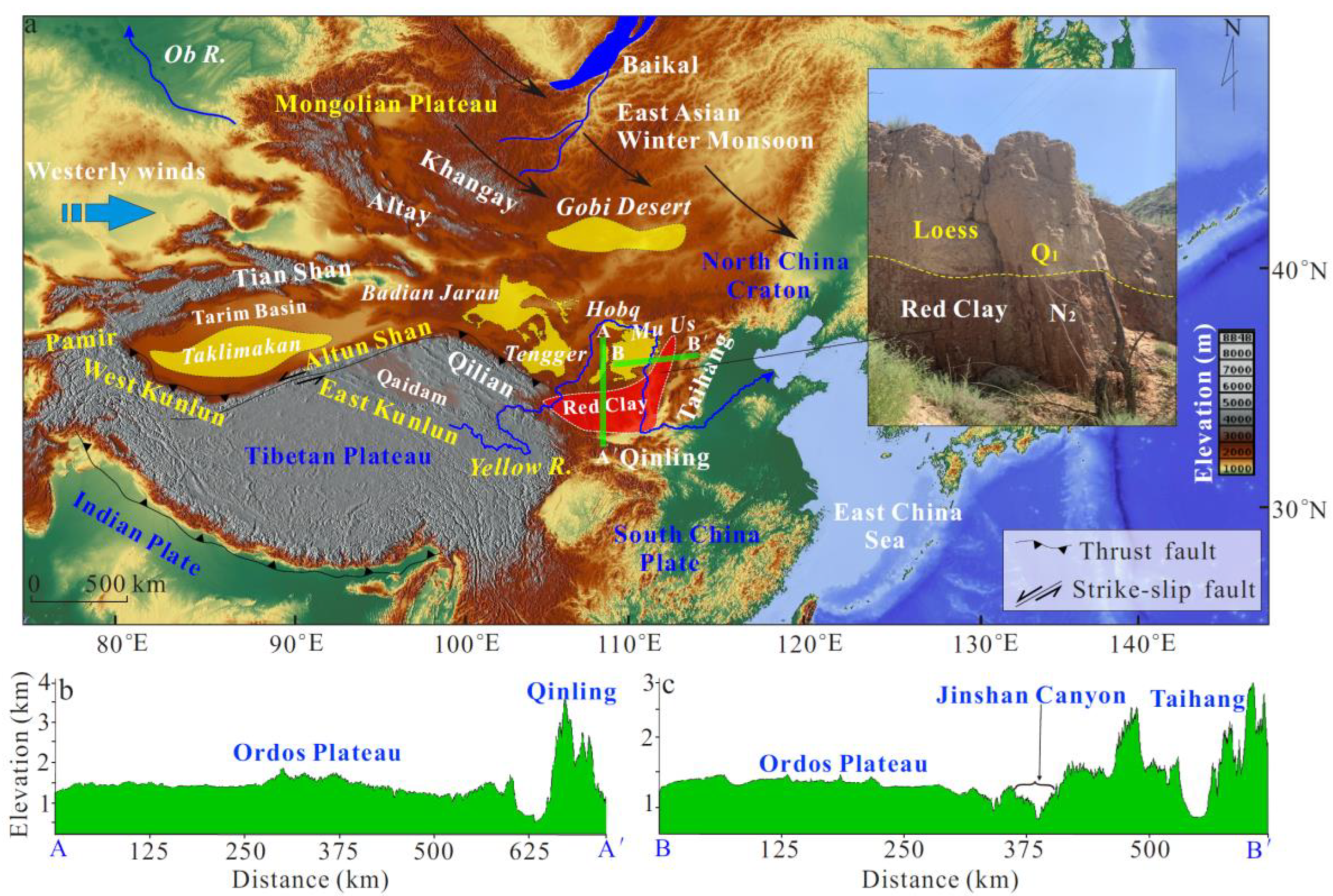
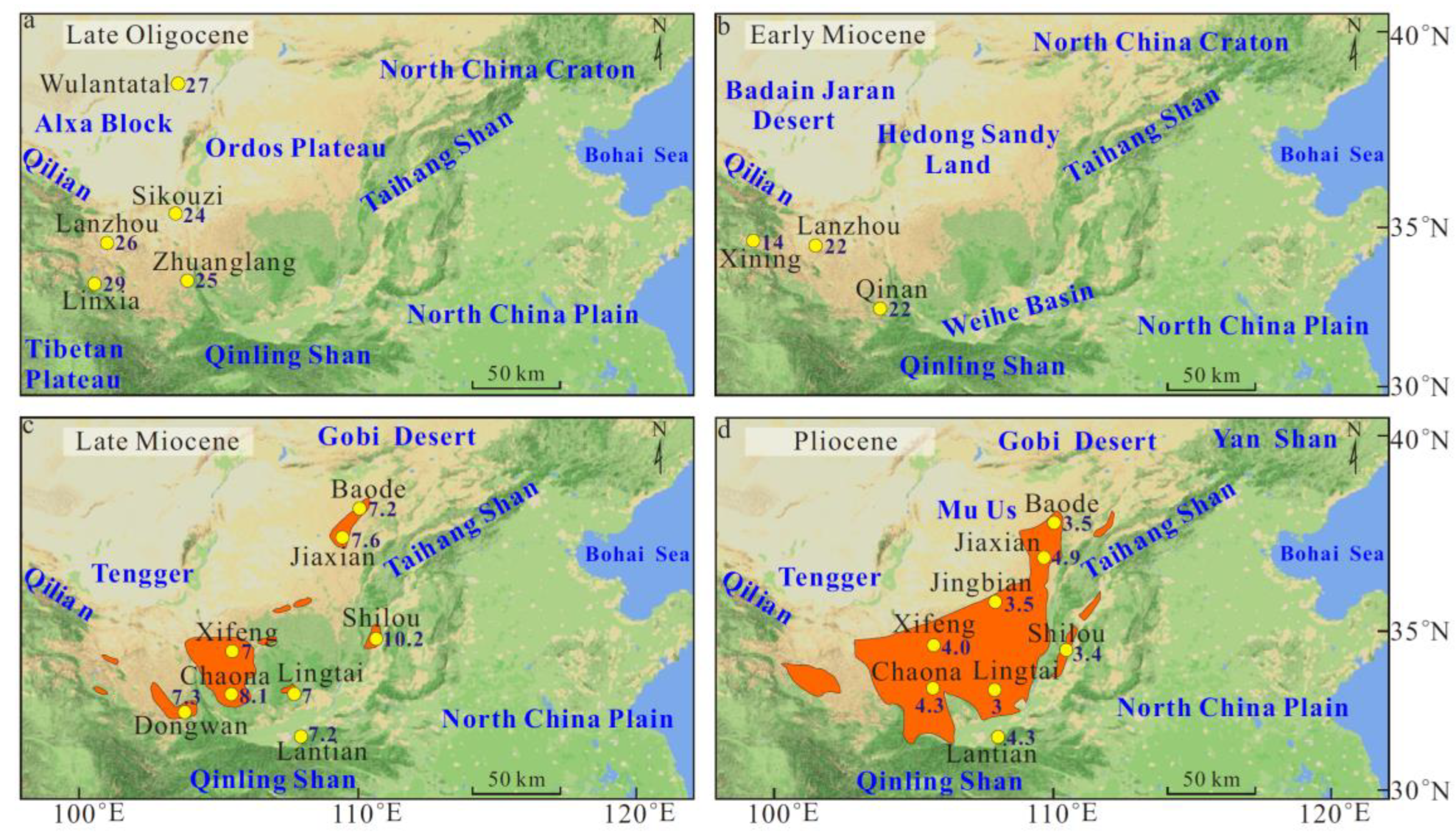


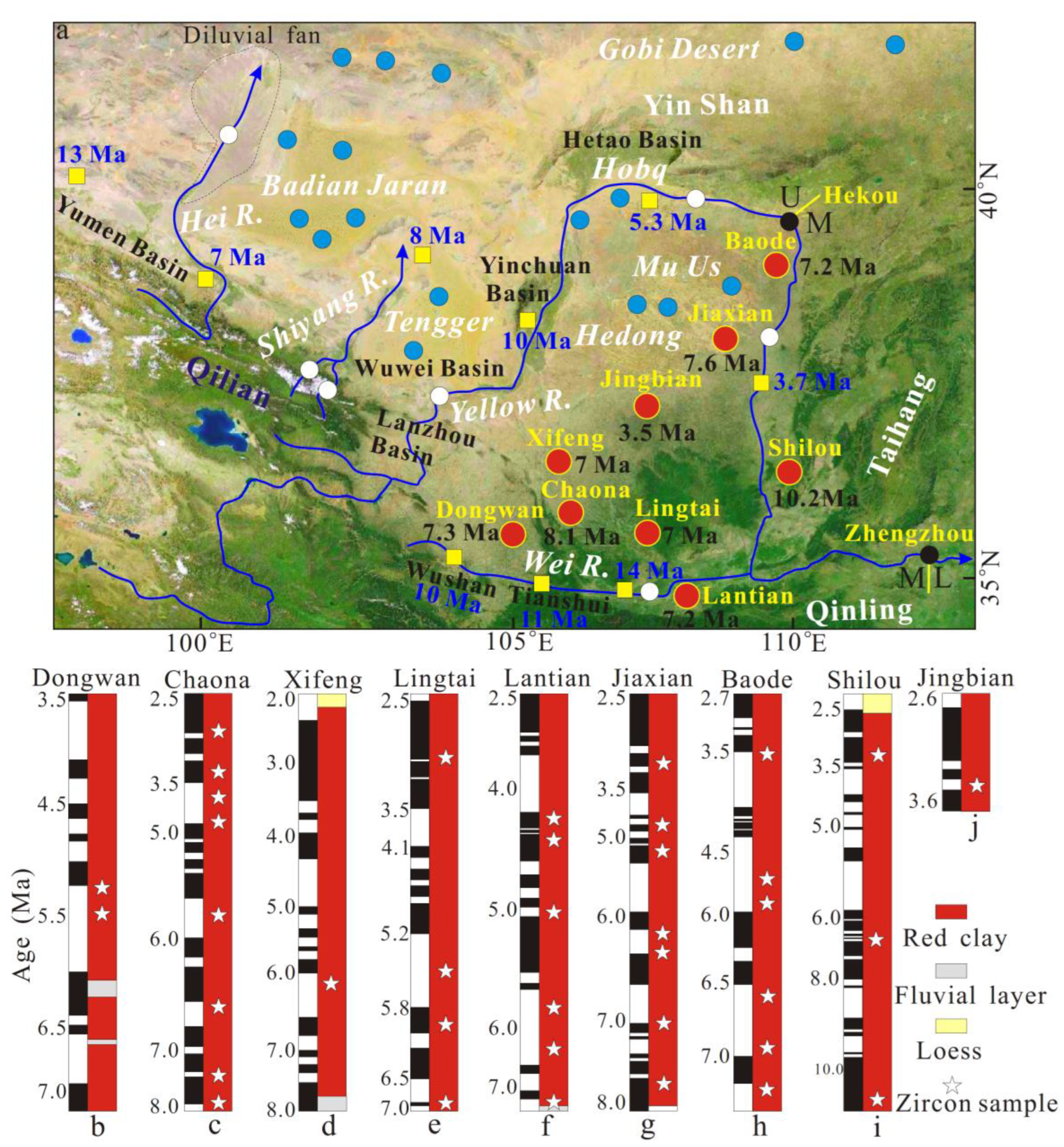
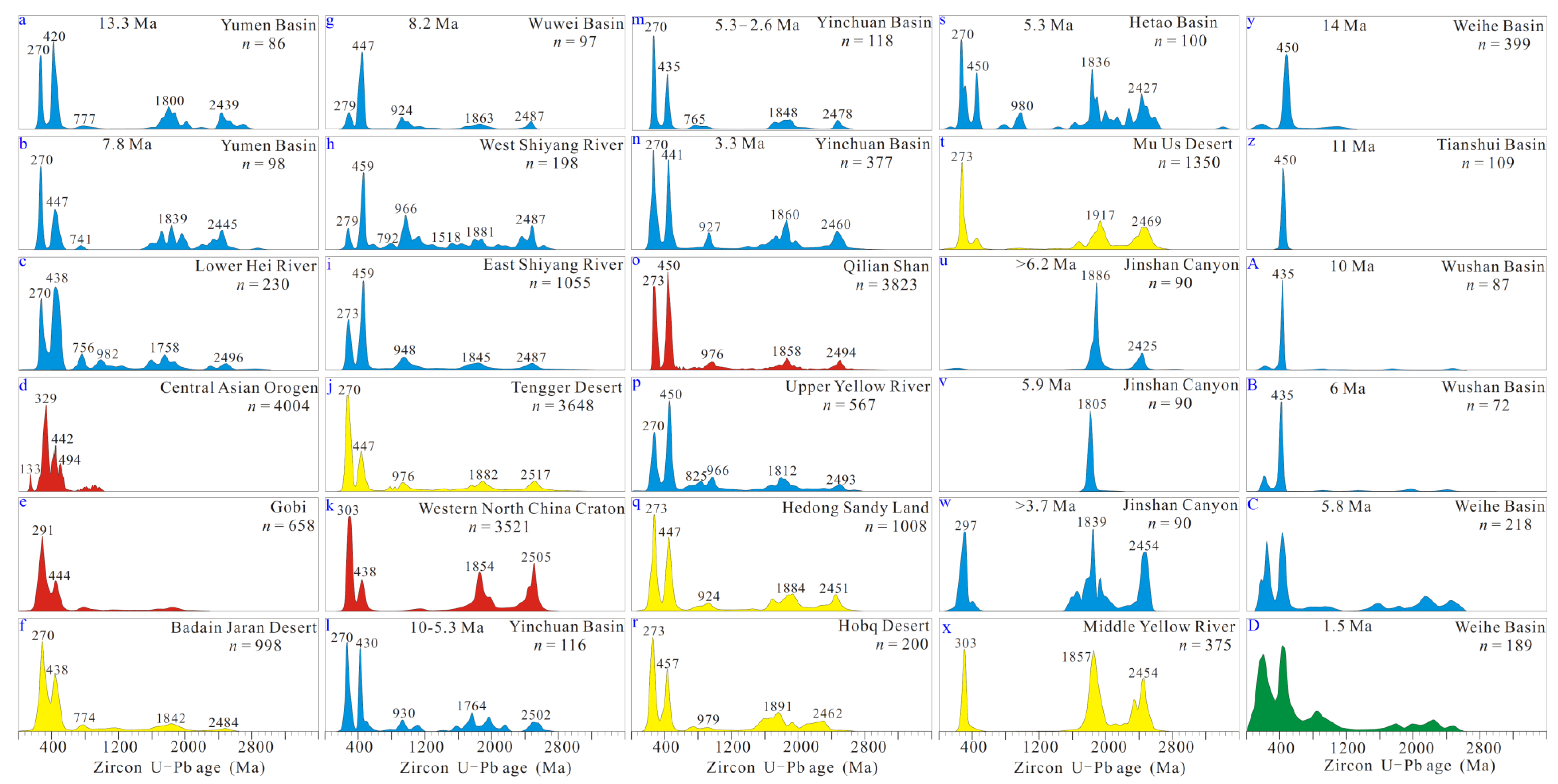



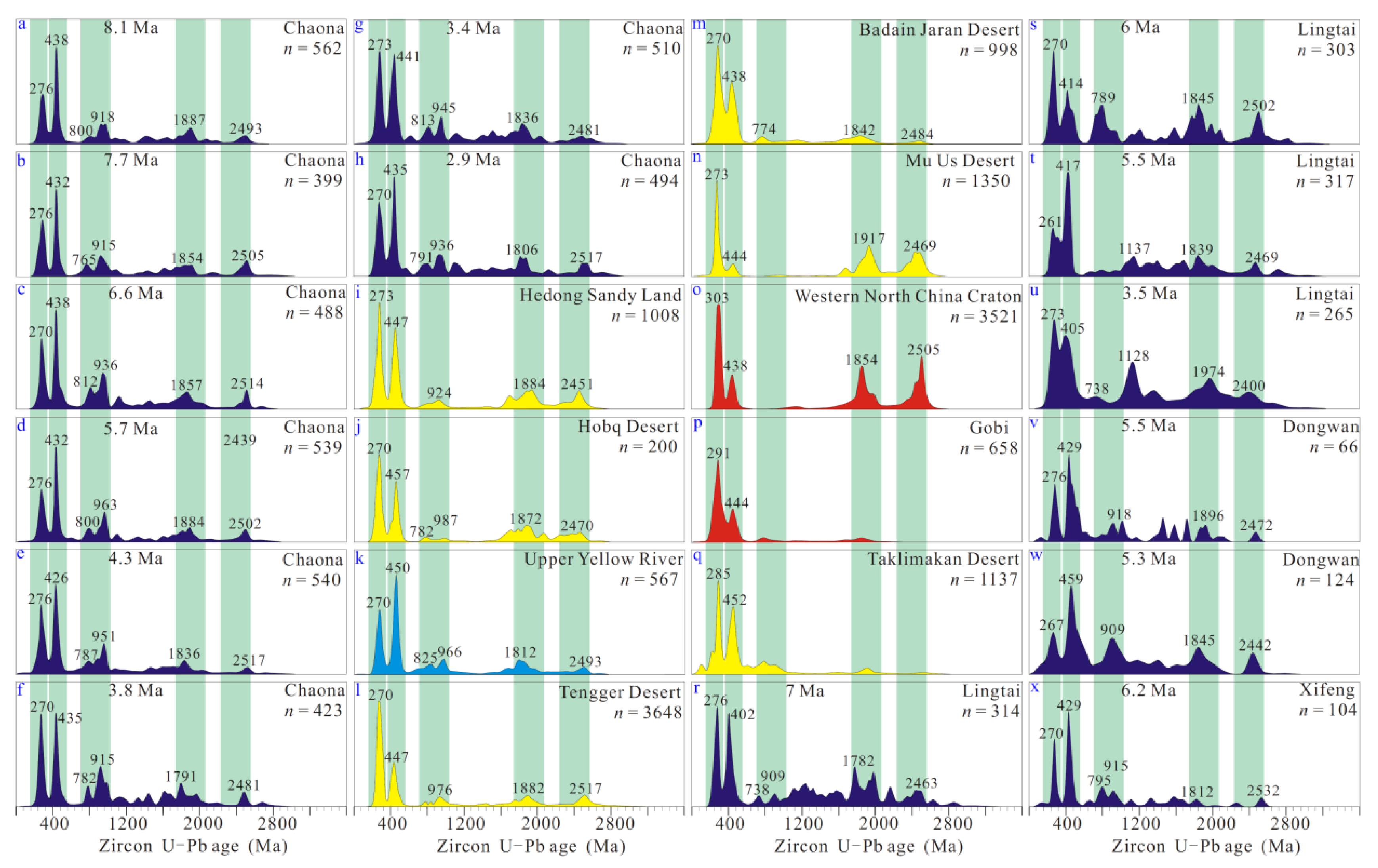
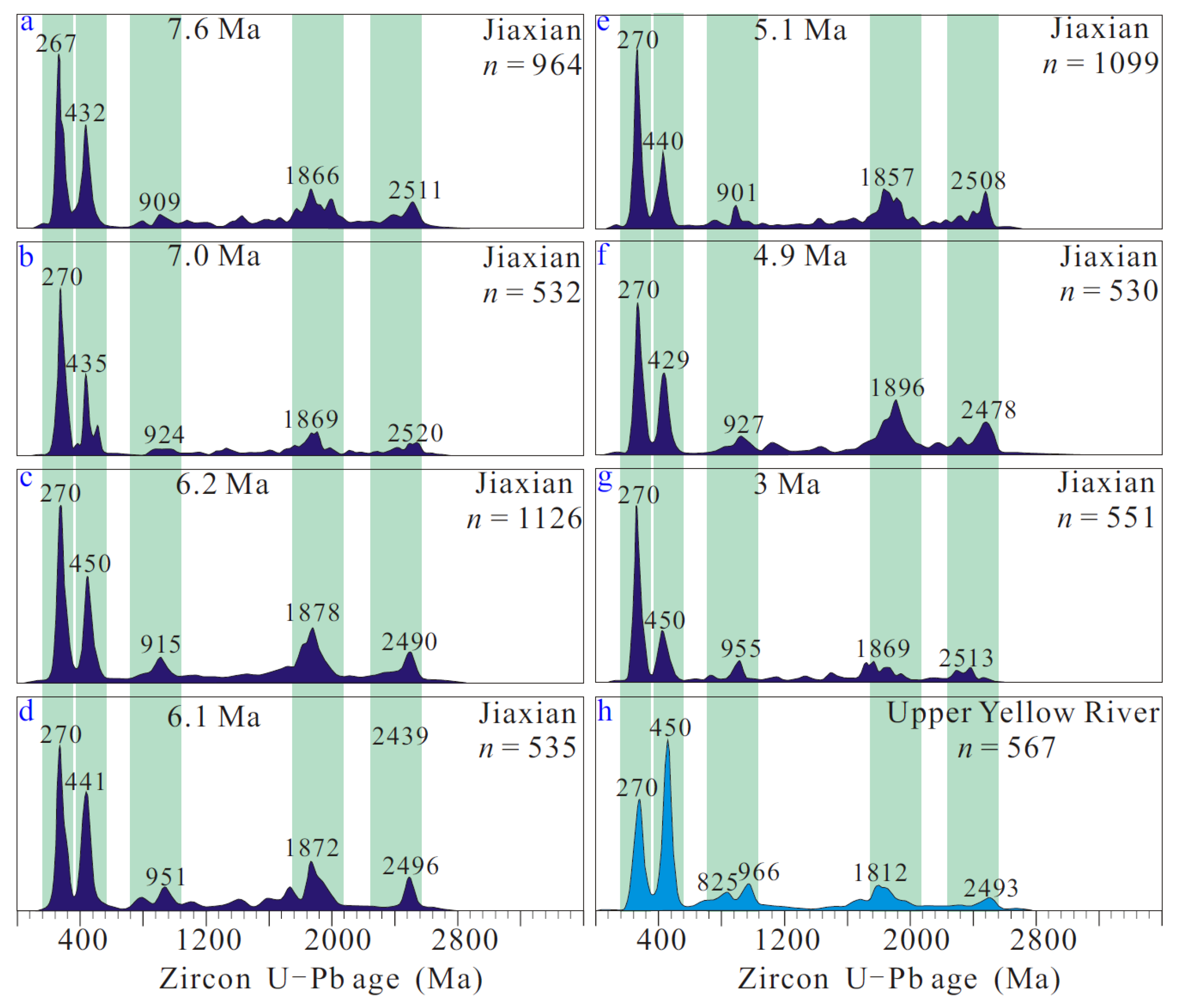


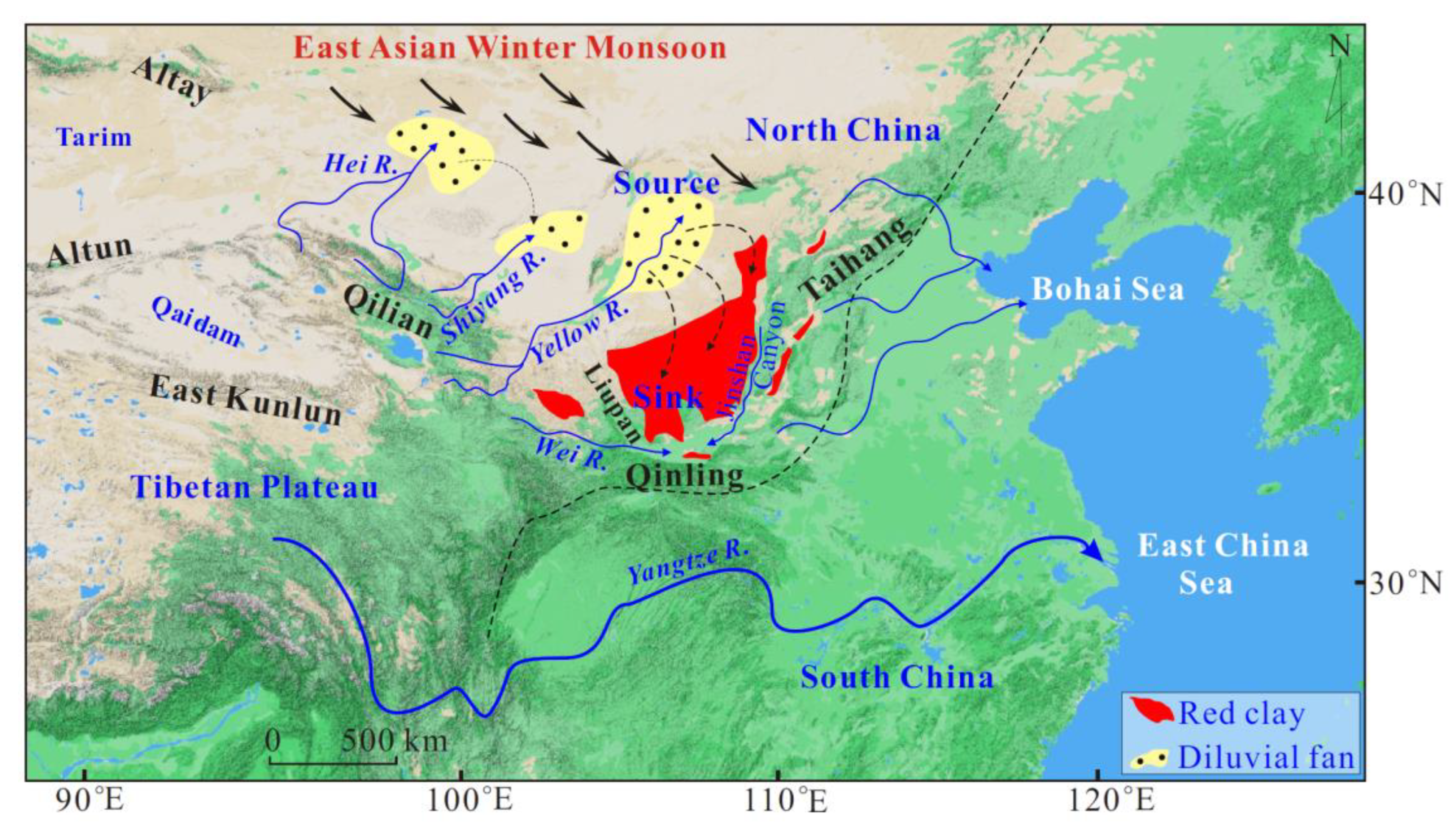
Disclaimer/Publisher’s Note: The statements, opinions and data contained in all publications are solely those of the individual author(s) and contributor(s) and not of MDPI and/or the editor(s). MDPI and/or the editor(s) disclaim responsibility for any injury to people or property resulting from any ideas, methods, instructions or products referred to in the content. |
© 2024 by the authors. Licensee MDPI, Basel, Switzerland. This article is an open access article distributed under the terms and conditions of the Creative Commons Attribution (CC BY) license (https://creativecommons.org/licenses/by/4.0/).
Share and Cite
Lin, X.; Hu, C.; Wu, R.; Qin, L.; Xiang, R.; An, Z.; Lu, H. How Was the Late Neogene Red Clay Formed in the Ordos Plateau (Northwest China)? Minerals 2024, 14, 537. https://doi.org/10.3390/min14060537
Lin X, Hu C, Wu R, Qin L, Xiang R, An Z, Lu H. How Was the Late Neogene Red Clay Formed in the Ordos Plateau (Northwest China)? Minerals. 2024; 14(6):537. https://doi.org/10.3390/min14060537
Chicago/Turabian StyleLin, Xu, Chengwei Hu, Ruitong Wu, Lishuang Qin, Runzhi Xiang, Zhengyang An, and Hang Lu. 2024. "How Was the Late Neogene Red Clay Formed in the Ordos Plateau (Northwest China)?" Minerals 14, no. 6: 537. https://doi.org/10.3390/min14060537
APA StyleLin, X., Hu, C., Wu, R., Qin, L., Xiang, R., An, Z., & Lu, H. (2024). How Was the Late Neogene Red Clay Formed in the Ordos Plateau (Northwest China)? Minerals, 14(6), 537. https://doi.org/10.3390/min14060537




